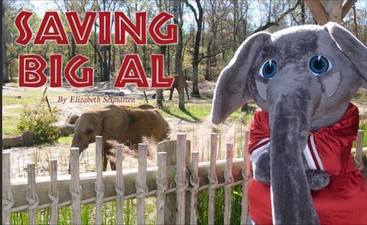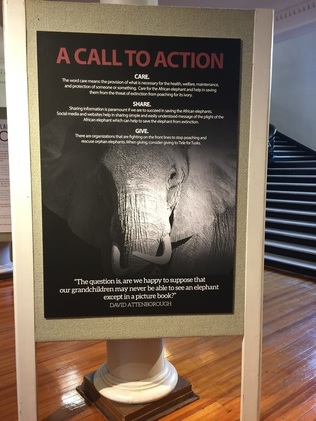 By Elizabeth Selmarten The African Elephant Project It was a brisk, Friday morning in late November. Leaves were on the ground but the sun shone bright, creating a beautiful day to take your family, or in my case, a certain beloved pachyderm mascot to the zoo. I escorted Big Al through the Birmingham Zoo straight to where his species, the African elephants, were roaming around. The meeting between the mascot and his real-life counterpart was almost something only to be imagined. It was simply incredible to watch Big Al bond and interact with Callee, one of the three bull elephants at the zoo. The two were like one in the same. Big Al would do one of his signature poses and Callee would follow his lead, mimicking the same poses. I just stood and watched in awe. I have never seen or heard of anything remotely similar to what I just witnessed in my life. Then I saw that it wasn’t just me watching the elephants and Big Al. We were surrounded by groups of children, teachers and parents, whom were all standing in awe as well. The little kids pointed excited towards Big Al and were yelling excitedly to each other about the presence of Big Al with real elephants and how they were doing the same thing. It was after that moment that it really hit me: how majestic and smart these large mammals are and if I don’t do something, they really could possibly be gone in as short as my lifetime. Future generations would never be able to have an experience like I had just had. Elephants could become the modern day dinosaur with the rise of poaching among other factors. The University of Alabama could seriously have an extinct mascot in the future. That thought seriously shook me up, as I dearly love elephants. To be honest, I’ve always loved elephants. My affection towards the tusked creatures started when I was a little girl, long before I had even heard of the University of Alabama. Lucky for me, it was a great coincidence that I ended up attending a school where my favorite animal just happened to be the mascot. My love for elephants eventually led me to pick up and cover a story last semester on a mascot conservation program, Tide for Tusks, for Mosaic Magazine. In my research and interviews, I quickly realized the horrifying truth about the endangered status of the African elephant. I had no idea prior to this story that every fifteen minutes, an African elephant is killed. I knew as soon as I found out, I had to tell this story to the best of my abilities for the African elephant, for Big Al. Along with my story designer and photographer, I arranged a photo shoot with Big Al at the Birmingham Zoo. It wasn’t till watching Big Al interact with Callee and seeing the children’s reactions that I changed from being just a writer dedicated to sharing a compelling story she found interesting. I became more than that. Deciding I could do more, I formally joined the club as well as the spring honors seminar class I had written about. I’ve learned so much in the class the opportunities out there, both field and non-field efforts. One of the biggest key-takeaways I’ve learned so far that I hope to help with in the future is raising awareness through building a brand with a website and active social media accounts. Raising awareness is one of the most crucial parts in order to successfully conserve mascots like the African elephant. This is one of the many ways I can help since I don’t have to travel to Africa or have scientific background to accomplish this. One of the most interesting aspects of mascot conservation is that anyone could contribute something to the cause, regardless of how small the contribution is. I hope to help Tide For Tusks increase awareness and action so we aren’t the generation that sees the extinction of the African elephant. It’s on us to help do our own part to save the elephants.
2 Comments
 Written by Amelia Kisling UA Student - African Elephant Project The concept of a class dedicated entirely to elephants made my heart sing, so of course I signed up immediately. I told everyone I could about it, and most people were jealous that I was getting class credit for simply talking about my favorite animal. I had no idea what to expect from my small honors seminar, and on the first day I realized this class would not be rainbows and butterflies – we were talking about reality, and that reality is that elephants are being killed. They are being killed for their beautiful ivory tusks at a rate of 96 elephants every day. When I met my classmates, I discovered that we all had different majors. Some were pre-med, some public relations, some psychology, some engineering. And then there was me – an accounting and criminal justice dual degree who felt a little lost on what I could possibly do to make a difference. I want to go into the FBI not open my own elephant conservatory. Then I learned something that changed my entire perspective on these elephant killings: Ivory poaching has been linked to funding terrorist groups in Africa. This was one of the most shocking things I had heard in the class. Not only were these gentle giants being poisoned and shot, butchered and beheaded for their tusks, but the ivory itself was used to help finance terrorist groups, one of the most universally feared things, enabling them to get all the weapons they need to continue killing across Africa. Learning this was my turning point; I knew I wanted my career to revolve around terrorism, so why shouldn’t it involve saving my favorite animal from being killed as well? So I did research. I read several articles about terrorist groups in Africa that use ivory trade as their main source of income. There were three terrorist groups that seemed to come up often: Somalia’s Al-Shabaab, the Lord’s Resistance Army, or L.R.A., and Darfur’s Janjaweed. The most prominent, however, was Al-Shabaab. Al-Shabaab is a Somali, al-Qaeda-backed terror group responsible for the Kenyan Westgate shopping mall massacre, which killed at least 68 people and left at least 150 people injured, back in September of 2013. Three years ago, the Elephant Action League, or EAL, conducted an 18-month undercover investigation into the link between Al-Shabaab and the illegal trafficking of ivory through Kenya. The organization’s findings suggested that Al-Shabaab has been actively buying and selling ivory to fund its militant operations and that ivory trafficking “could be supplying up to 40% of the funds needed to keep them in business’’ (AEL: Africa’s White Gold of Jihad). With anti-poaching tactics so poorly funded, terrorist groups find poaching an easy option to fund their organizations. Even rangers have been gunned down trying to protect elephants, but when groups like Al-Shabaab come in from the sky on helicopters and shoot elephants before they even know what happened, a handful of rangers really don’t stand a chance. Wildlife agencies aren’t prepared to fight terrorist groups and rebel armies, it’s not how they operate. And with increased ivory prices, poaching has increased as a result. Luckily, the United States has begun to view wildlife trafficking as a national security threat. This publicity on such a serious matter is incredible progress, but it will not make this problem go away. It is, however, a great start. Nothing about ivory poaching is beneficial. Elephants are being killed, altering entire ecosystems in their absence, watering holes are being poisoned, killing more than just those elephants they are taking ivory from, and at the end of the day, another terrorist group gets to put guns in their hands. This means that its not just the elephants that are dying – people are dying, too. The African Elephant Project taught me that I don’t need to be experienced with biology or non-profit or even large animal care to take a stand against such heinous crimes. With just a little more knowledge than I had before my first day, I now see where my place is in this fight. It may not be in Tanzania at an elephant orphanage. I may not do research on protective tactics for these amazing creatures. I may never even go to Africa. This does not mean I won’t do everything in my power to make a difference in this fight. And all it took was one fact to make me realize that. Written by Shelby Critcher
UA Student - African Elephant Project I would venture to say that elephants are many people’s favorite animals; I know they are one of mine. Elephants are not only awesome to look at but they are an extremely important component to our ecosystem. They serve as a keystone species, meaning that if elephants did not exist the entire ecosystem would be drastically altered or possibly cease to exist. While elephants are still one of my favorite animals, I have learned while being in my African Elephant Project class that they are not exactly harmless creatures. My previous thought that they were simply gentle giants has been proven incorrect. Besides the terrible killings of elephants by poachers who are killing the elephants strictly for ivory there are still many other reasons why elephants are dying today and in turn, causing the elephant population to be on the decline. One of these reasons is because elephants in Asia and Africa raid farmers crops. These crops are how these people make their living and with that being threatened and possibly destroyed in as little as one night by a heard of elephants they are forced to take extreme measures, some which have ended in death of both the humans and elephants. This problem was one that I had not heard of before and it greatly saddens me because elephants already face enough because of the poachers. Elephants are herbivores meaning there is no reason for them to attack humans unless provoked. In learning about this I am excited to tell you that there is a solution! Bee hives! Who would have thought? Beehive fences are still experimental but have had great success to date. The basic idea is that beehives are placed every 10 meters and connected with a series of wires so that if an elephant runs into a wire it will disturb the beehive releasing the bees. The buzzing of the bees instantly causes the elephants to turn away, or at least that is the goal. Research has been done on the effect of bees on elephants and this is where the idea came from. These beehive fences have many other advantages as well. They are relatively cheap, costing between $150-$500 every 100m depending on the type of beehives you use. They reduce the number of elephant crop raids, which is the ultimate goal. By preventing these raids it also decreases the cost that the farmers have to pay in damages caused by the elephant raids. Another bonus is the additional income that comes from the honey produced by the beehives. I am excited that beehive fences are growing in Africa and Asia and research still continues with this idea. There is no reason for more elephants to die. By being in this class I have learned so much already about awareness and I hope through this I have also made you aware. Please share this new information with others in hopes of increasing awareness and making a difference. |
AuthorRandy Mecredy is the cofounder and CEO of Tide for Tusks. Archives
April 2016
Categories |


 RSS Feed
RSS Feed
